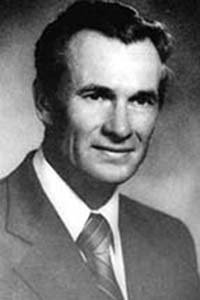
Eminent Farmer
County: Tripp
Martin Jorgensen is a Tripp County farmer-rancher noted for his accomplishment in agriculture and his efforts in improving the rural life in South Dakota. His award as Eminent Farmer came just 19 years after the same honor was bestowed on his father, Martin, Sr.
Jorgensen graduated from Ideal High School in 1942 and entered into a partnership with his father. He married his wife, Mary, in 1946, and the couple now has raised a family of two sons and two daughters.
The Jorgensen operation is diversified and includes not only the lands in the Trip County area, but also 1800 acres of partly irrigated land in Brookings County. Over the years, he has built a registered herd of Angus cattle which enjoys a national reputation.
The Jorgensen program of selection and performance testing has been followed and duplicated by many in the cattle industry. The operation also features a 150-sow farrowing and finishing unit and farming enterprises which include milo, wheat, other small grains, alfalfa and sorghum row crops for silage.
Jorgensen helped to form The Performance People, a group of Angus producers who united to establish their own newspaper, "The Ideal Beef Memo," a publication dedicated to recognizing the performance of Angus and other breeds.
His interest in rural water led "almost to a full-time job" as he worked to establish a system to serve his area. The effort began with an informational meeting on rural water systems called by former Tripp County Agent Ray Eilers. Jorgensen was named to chair the steering committee.
Good water was a scarce commodity in those days, and the group saw a potential source in the high ground in the southern part of the county. That area offered access to the extreme northern edge of the Ogallala Aquifer, and the elevation there had potential to gravity-feed most water lines.
"That was the most effort I gave any one thing in my life," said Jorgensen in describing those years of toil. "But I really cherish the experience and the knowledge I gained."
Looking back on his 40 years in the industry, Jorgensen says it still bothers him that his fellow farmers and ranchers don't adopt a generally more aggressive attitude toward management. "If we have a short-coming in agriculture today, it is that we as operators don't recognize that whatever we produce, we also have to sell. And, if it has to be sold, it can best be done if we involve ourselves in the process of selling. We need closer touch with all markets and with the computer, we have the capability to know all this.
"As I become older, I spend more and more of my time just studying markets and this has yielded pretty good fruit," he added.

